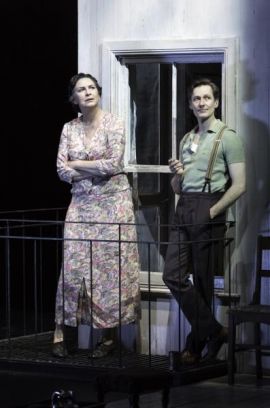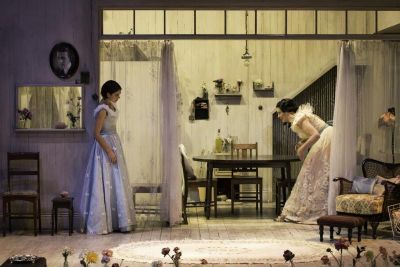The Glass Menagerie
This Belvoir Street production of The Glass Menagerie is not for the faint hearted - it is long and robust, contemporary and acutely perceptive.
The quasi-autobiographical ‘Memory Play’ of Tennessee Williams’s early adult life in a small apartment with his deluded mother and vulnerable fragile sister, with whom he felt a deep connection is especially revealing.
Although Tom, the Williams character, is able to walk away into another life, it is an era when women had limited options. So the only respectable way out of a dysfunctional family setting for daughter Laura is through marriage. However, due to social isolation and desperate shyness and a mild disability she has no mobility and is doomed to spinsterhood. And yet there is a poignant glimmer of hope.

Interesting choices have been made around characterization. Rose Riley plays Laura in a lovely open way - using a natural voice and unapologetic physical presence. Riley’s Laura exhibits some startling, deeply disturbing and telling behavioral traits.
Harry Greenwood plays Jim O’Connor, the gentleman visitor, with sympathetic self-awareness. He doesn’t overtly express any sense of repulsion that his character might be feeling towards Amanda and Laura and the smothering situation in which he finds himself. This adds a rich dimension to the second act and the touching scene between Laura and the gentleman caller that is delightful staged and enhanced by marvelous lighting (Damien Cooper).
As Tom Wingfield Luke Mullins shines. He brings the audience into his world with the seemingly effortless charm of Tennessee Williams. He moves fluidly in and around the apartment, through windows, doors and curtains, documenting all the while - particularly through the setting of cameras.
Pamela Rabe’s characterization of the stifling, disturbed Mother Amanda is inescapably larger than life. She is a grand puppet master – with invisible strings jerking at her children’s emotional well being. There is an uncanny sense that the set (Michael Hankin) is a little smaller than a real life apartment and has something of a dolls house about it. Rabe’s Amanda fills and dominates this space. Sometimes what she mutters seems almost indistinguishable as though she is not fully expecting her children to be listening to her.
Desperation and insecurity imbues this archetypal ‘Southern Belle’ who has been rejected and escaped by a philandering husband. She is left with two very sensitive adult children with whom a dance of crippling co-dependency takes hold. Ambivalence reigns and emotional blackmail abounds. It has the potential to touch any raw nerve of familial dysfunction in the viewer.
 As director, Eamon Flack has elicited very strong choices from his cast and creatives that allow for a truly insightful production highlighting isolation, vulnerability and replacing some of the pathos usually emphasized with a contemporary sense of angst, even anger.
As director, Eamon Flack has elicited very strong choices from his cast and creatives that allow for a truly insightful production highlighting isolation, vulnerability and replacing some of the pathos usually emphasized with a contemporary sense of angst, even anger.
One could be forgiven for thinking that Flack has imposed a contemporary post –modern sensibility on this staging through a use of multi media. However nothing could be further from the truth as a great many of the stage directions and particularly the use of filmic projections are specified in the text.
Beautiful rich melodies transport the audience from scene to scene thanks to sound designer Stefan Gregory.
Mel Page’s costuming is great including having Amanda wear a man’s dressing gown and a dress that she has definitely grown out of - with a zip on the back that doesn’t fully do up.
Tennessee Williams is truly honoured through this insightful production.
Suzanne Sandow
Photographer credit: Pia Johnson / Malthouse Theatre / Belboir
Credits
Video Design Consultant – Sean Bacon
Lighting Designer – Damien Cooper
Composer and Sound Design – Stefan Gregory
Set Designer – Michael Hankin
Costume Designer – Mel Page
Subscribe to our E-Newsletter, buy our latest print edition or find a Performing Arts book at Book Nook.

